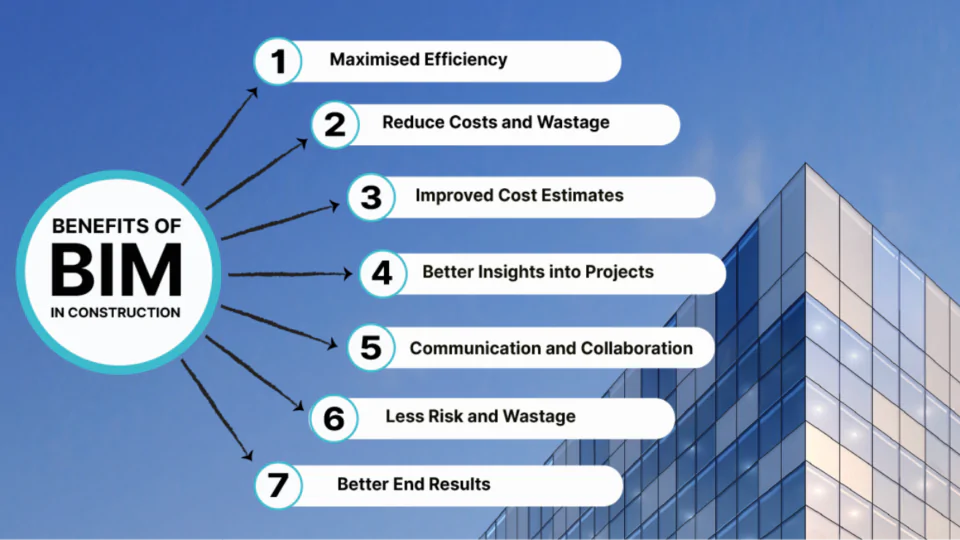Benefits of BIM Technology for Structural Engineers

Table of Contents
Building Information Modeling (BIM) is a digital technology that has transformed the way structural engineers design and analyse building structures. To better understand the rate of adoption of BIM by structural engineers in the coming years, the report published by Dodge Data and Analytics in 2021 states that in the coming 2-3 years, 80% of structural engineers will be using BIM on 50% or more of their projects.
BIM is a collaborative approach to building design, construction, and maintenance that involves creating a virtual model of the building that contains detailed information about its components and systems. This digital technology has various benefits, such as better collaboration, coordination, simulations, and clash detection. In this blog, we will find out more about the roles and responsibilities of the professionals and the benefits of BIM for structural engineers.
Who is a structural engineer ?
While an architect is concerned about the design of the built form, a structural engineer is more concerned about its strength and stability. Structural engineers analyse, design, plan, and research structural components and structural systems to ensure the safety of the building’s users. Let us look at the roles and responsibilities of a structural engineer to better understand their deliverables:
- Calculating the load and stress that a building can withstand
- Using computer-aided software to calculate a building's reaction to weather
- Obtaining the regulatory permits for the construction of a building
- Preparing cost estimates of structures and selecting materials for a building
- Supervising building construction and advising project managers
- Collaborating with other professionals like architects, engineers, and builders to deliver a project
- Managing projects and administering contracts

Applications of BIM in Structural Engineering
Building Information Modeling (BIM) is an intelligent, 3D model-based process that helps structural professionals design, detail, document, and fabricate structural systems. Let us look at the various applications that result in the benefits of BIM for structural engineers.
1. Real-time Coordination in BIM structural engineering
Any large-scale architectural project includes the involvement of various stakeholders. This makes coordination between these stakeholders necessary - and the collaborative nature of BIM not only allows the project team to coordinate better but also allows better design decisions to be locked in using the data-driven business model. Revit and Navisworks are important and the best BIM softwares for structural engineers that can be used for this purpose.
2. Visualisation in BIM structural engineering

Another benefit of BIM for structural engineers is to visualise elements in 3D. This provides them with good project insight, enhances understanding between stakeholders, and facilitates solving problems. These 3D models can also be analysed for stress, strain, and deflection. This analysis helps engineers identify potential issues early in the design process, reducing the risk of costly mistakes and delays during construction.
3.Energy-efficiency and sustainability in BIM structural engineering
BIM can also be used for energy simulation. These include daylight analysis and thermal performance analysis. By analysing the behaviour of building structures under different environmental conditions, engineers can identify opportunities to reduce energy consumption and carbon emissions. For example, best BIM softwares for structural engineers can be used to analyse the impact of daylighting on building energy consumption and optimise the placement of windows and skylights for maximum energy efficiency.
Also Read: Exploring the Most Innovative BIM Projects in Europe {2023}
4. Structural Analysis in BIM structural engineering
%20Modelling%20for%20Smoke%20Extraction%20London%20%E2%80%93%20Firenze.jpg?width=1000&height=509&name=Computational%20Fluid%20Dynamics%20(CFD)%20Modelling%20for%20Smoke%20Extraction%20London%20%E2%80%93%20Firenze.jpg)
BIM software can be used for structural analysis, including finite element analysis (FEA) and computational fluid dynamics (CFD). These simulations can help engineers test the structural integrity of a building and identify potential issues before construction begins.
Interested in the intersection between BIM and computational design? Check out: What's New in Architecture - Automation, Coding, and BIM!
5. Cost Estimation in BIM structural engineering

Best BIM softwares for structural engineers can be used for cost estimation, including material quantities and labour costs. This can help engineers identify potential cost savings and optimise the building design for cost-effectiveness.
Popular and Best BIM software used by structural engineers
BIM software brings various functional values. From advanced functions to software built for specific industries and companies, BIM helps in improving communication, reducing overruns and preventing delays. Here’s a list of some of the best BIM software for structural engineers.
1. Revit

Revit is a powerful, Best BIM Software for structural engineers developed by Autodesk, designed to aid architects, engineers, and construction professionals in the design and construction of buildings and infrastructure projects. It enables users to create detailed 3D models of building structures and systems, which can be analysed for performance, energy efficiency, and constructability.
2. Robot Structural Analysis Professional
Robot Structural Analysis Professional is structural load analysis software developed by Autodesk. The software verifies code compliance and uses BIM-integrated workflows to exchange data with Revit. It can help structural engineers create more resilient, constructible designs that are accurate, coordinated, and connected to BIM. The software features BIM-integrated workflows, wind load simulation, and extensive analysis capabilities, to name a few. These further form the benefits of BIM for structural engineers.
3. Advance Steel
Advance Steel software is a 3D software for steel model design and fabrication. It aims to drive collaboration between engineers and detailers, improve coordination, clarify design intent, and reduce rework. With Advance Steel, structural engineers can achieve a seamless design and detailing workflow for projects in BIM, move quickly from design to fabrication, and streamline steel fabrication and installation.
4. ETABS
ETABS is used for the analysis, design, and modelling of building structures. It can analyse the behaviour of structures under various load conditions, such as seismic, wind, and gravity loads. It offers a range of tools for designing various building systems, including concrete, steel, and composite structures.
What are the benefits of BIM for structural engineers?

Building Information Modeling (BIM) has modernised and brought technology to the forefront of the profession of structural engineers. Here are five key benefits of BIM for structural engineers:
1. Enhanced Collaboration: One of the most significant benefits of BIM is the ability to collaborate with other members of the design team in real time.
Improved Accuracy: BIM software enables engineers to create accurate 3D models of buildings.
2. Improved Productivity: BIM helps automate a lot of the work, which leads to structural engineers doing less manual work and more meaningful work. This helps improve productivity.
3. Enhanced Safety and Security: This benefit of BIM for structural engineers can enhance the safety and security of building structures by analysing their behaviour under different environmental conditions. Engineers can identify potential safety hazards and security risks, and develop strategies to mitigate them.
4. Higher salaries: BIM-skilled engineers earn 40% more than the industry average. This is because BIM skills are in high demand but in short supply. According to industry information aggregators such as www.talent.com, the average structural BIM engineer salary in the USA is $85,000 per year or $43.59 per hour.
For more insights about the career opportunities for civil engineers in the field of BIM, check out: BIM for Structural Engineers: Top Benefits, Significance, and Work Opportunities {2023}
List of BIM course suggestions for structural engineers
Now that we have established the relevance and benefits of BIM for structural engineers, let us look at some BIM course suggestions for structural engineers to get you started.
1. Novatr
Mode: online, part-time
Completion time: 6 months
Novatr offers a BIM Professional Course for Civil Engineers for structural engineers that features a specialised, career-relevant curriculum designed and delivered by BIM experts from leading firms. The 6-month offering involves online part-time study and equips learners with a holistic understanding of BIM processes and software knowledge spanning modelling, information management, cloud collaboration, presentation, clash detection, and visual programming. The course allows students to learn from AEC professionals leading BIM at top-tier firms worldwide and work on a live, RIBA-structured capstone project to practise their skills.
2. Skill Lync
Mode: Online
Completion time: 8 to 12 months
The "Drafting and Design using Revit" course offered by Skill-Lync provides BIM training on both parametric design skills and drafting standards to create error-free drawings. The website suggests that the course is suitable for students of civil engineering in their first, second, third, or final year, as well as employees in civil engineering firms who are looking to upscale in their profession.

3. BIM Labs
Mode: Offline
Completion Time: 240 hours - 850 hours
BIMLabs offer aspiring professionals a platform and the tools to efficiently plan, design, construct, and manage buildings and infrastructure. They have an offline training centre in Kerala. BIMLabs also offers placement opportunities after the completion of the course.
4. TechnoStruct Academy
Mode: Online and E-Live Classes, Classroom Training in Hyderabad and New Delhi
Completion Time: 8 months (for the BIM-ready+ course)
TechnoStruct Academy provides online training courses to prepare in the fields of BIM, AutoCAD, Revit, and NavisWorks. TSA is the training division of the US-based engineering and technology BIM firm TechnoStruct LLC.
Conclusion
As we are advancing in the AEC industry, collaborative approaches and virtual modelling is what we are looking at. BIM is one such technology that will benefit the construction industry with better collaboration, simulations, clash detection, and coordination. These are just a few of the many benefits of BIM for structural engineers.
That’s it. We hope this blog gives you the insight you need to accelerate your career in the architecture, engineering, and construction (AEC) industry by helping you learn the relevance and benefit of BIM for structural engineers.
Interested in learning more about BIM and its career opportunities? Go to our
Resources page to find more insights on these topics and more.
Interested in learning more about BIM Modeling? Here’s something that might interest you:
Novatr offers you a course in BIM Professional Course for Architects that will help you understand computation in different design fields with industry workflows, advanced tools for a concrete foundation in computational design. Learn high-performance computational BIM and building analysis via a live industry project. Bag opportunities along with professional certification, endless career possibilities and upskilling.

 Thanks for connecting!
Thanks for connecting!

.png)


-1.png)




